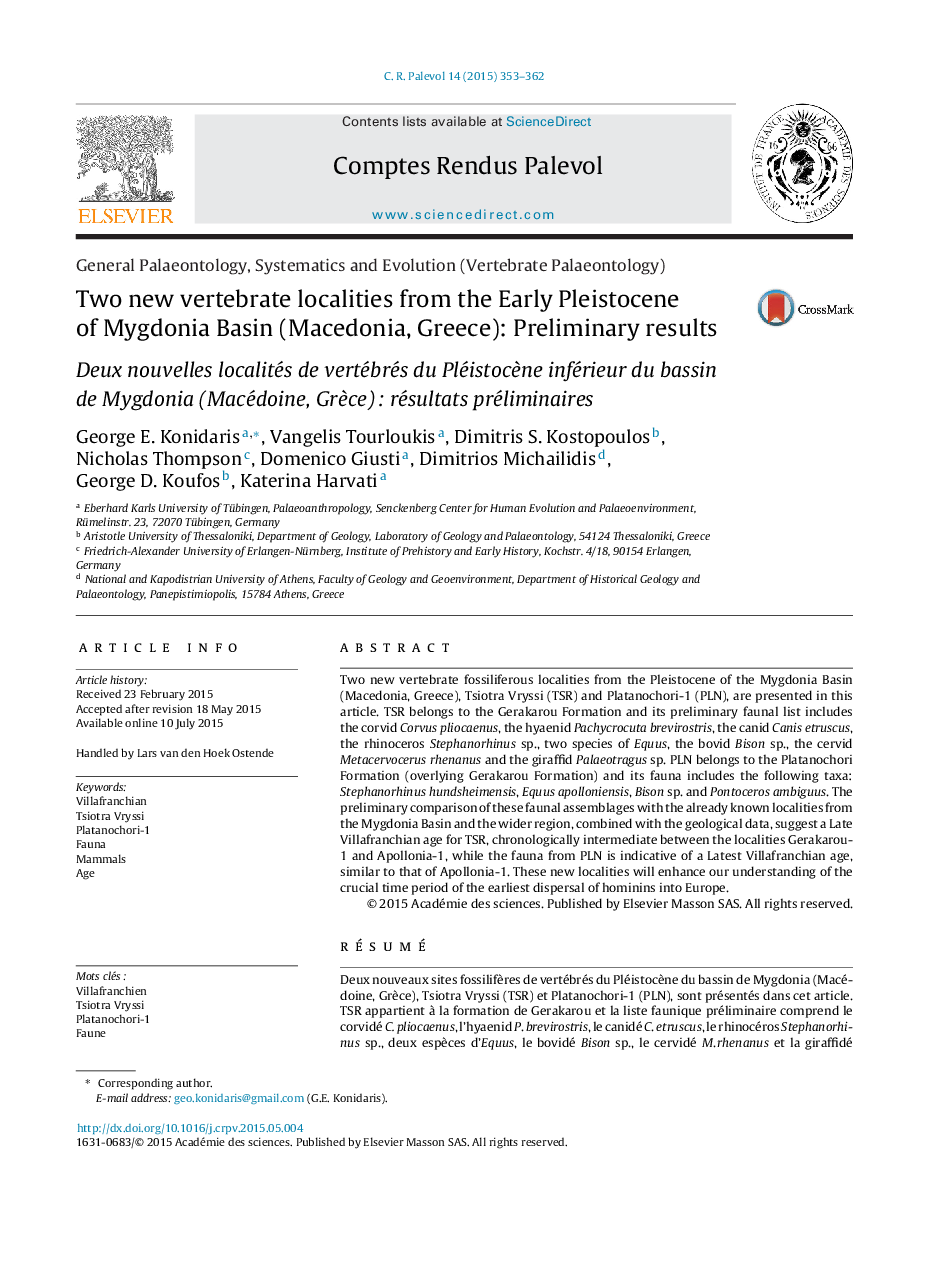| کد مقاله | کد نشریه | سال انتشار | مقاله انگلیسی | نسخه تمام متن |
|---|---|---|---|---|
| 4745684 | 1359773 | 2015 | 10 صفحه PDF | دانلود رایگان |

Two new vertebrate fossiliferous localities from the Pleistocene of the Mygdonia Basin (Macedonia, Greece), Tsiotra Vryssi (TSR) and Platanochori-1 (PLN), are presented in this article. TSR belongs to the Gerakarou Formation and its preliminary faunal list includes the corvid Corvus pliocaenus, the hyaenid Pachycrocuta brevirostris, the canid Canis etruscus, the rhinoceros Stephanorhinus sp., two species of Equus, the bovid Bison sp., the cervid Metacervocerus rhenanus and the giraffid Palaeotragus sp. PLN belongs to the Platanochori Formation (overlying Gerakarou Formation) and its fauna includes the following taxa: Stephanorhinus hundsheimensis, Equus apolloniensis, Bison sp. and Pontoceros ambiguus. The preliminary comparison of these faunal assemblages with the already known localities from the Mygdonia Basin and the wider region, combined with the geological data, suggest a Late Villafranchian age for TSR, chronologically intermediate between the localities Gerakarou-1 and Apollonia-1, while the fauna from PLN is indicative of a Latest Villafranchian age, similar to that of Apollonia-1. These new localities will enhance our understanding of the crucial time period of the earliest dispersal of hominins into Europe.
RésuméDeux nouveaux sites fossilifères de vertébrés du Pléistocène du bassin de Mygdonia (Macédoine, Grèce), Tsiotra Vryssi (TSR) et Platanochori-1 (PLN), sont présentés dans cet article. TSR appartient à la formation de Gerakarou et la liste faunique préliminaire comprend le corvidé C. pliocaenus, l’hyaenid P. brevirostris, le canidé C. etruscus, le rhinocéros Stephanorhinus sp., deux espèces d’Equus, le bovidé Bison sp., le cervidé M. rhenanus et la giraffidé Palaeotragus sp. PLN appartient à la formation Platanochori (recouvrant la formation Gerakarou), et sa faune comprend les taxons suivants: S. hundsheimensis, E. apolloniensis, Bison sp. et P. ambiguus. La comparaison préliminaire de ces assemblages faunistiques avec les localités déjà connues du bassin de Mygdonia et la région alentour, combinée avec les données géologiques, suggèrent un âge Villafranchien supérieur pour TSR, chronologiquement intermédiaire entre les localités Gerakarou-1 et Apollonia-1, tandis que la faune de PLN est indicative d’un âge Villafranchien terminal, similaire à celui d’Apollonia-1. Ces nouvelles localités permettront d’améliorer notre compréhension de la période cruciale qui vit la première dispersion des homininés en Europe.
Journal: Comptes Rendus Palevol - Volume 14, Issue 5, July–August 2015, Pages 353–362